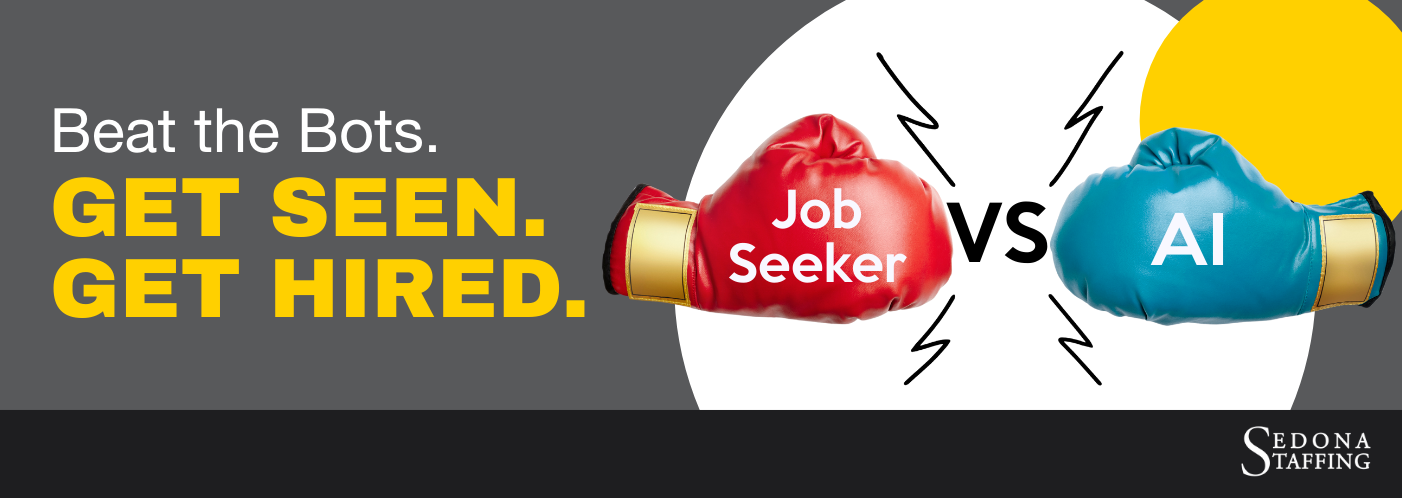AI, Algorithms, and the Job Search: How to Stand Out in the Age of Digital Screening
The Modern Job Search: Where Technology Screens and Humans Decide

If it feels harder to get noticed after submitting an online job application, you’re not imagining things. Behind nearly every “Apply Now” button today is an algorithm quietly sorting through resumes before a human ever sees them.
Artificial intelligence and automated screening tools have become a normal part of recruiting. They help employers manage hundreds of applications efficiently, but they also make it easy for strong candidates to get overlooked if their resume isn’t formatted or phrased the right way.
At Sedona Staffing, we sit on both sides of the hiring equation. We understand how automated systems screen applications because we use them too — and we also hear every day from job seekers who apply to hundreds of positions without a single response. That’s why we focus on bridging the gap: helping real people get seen, and making sure employers don’t miss out on great talent the algorithms might overlook.
What AI Actually Does in Hiring
Most companies now use what’s called an Applicant Tracking System (ATS)—software designed to collect, organize, and screen resumes. Some versions simply look for keywords that match the job description. Others are more advanced, analyzing work history, education, and even phrasing patterns to predict fit.
The goal isn’t to replace recruiters; it’s to make sorting faster. The challenge is that computers can’t always read context. If your resume doesn’t match the system’s expectations, it might never make it to the top of the pile, even if you’re a perfect fit.
Why Keywords Still Matter
Every job posting contains clues about what the algorithm is looking for. Those keywords—specific skills, software names, certifications, or job titles—act as signals that tell the system you’re qualified.
The trick isn’t to stuff your resume with buzzwords, but to speak the same “language” the job description uses. For example:
● If the posting says “Microsoft Excel proficiency,” avoid abbreviating it as “MS Excel.”
●If it lists “customer relationship management systems,” include “CRM software” and the specific tool you’ve used.
These small adjustments help ensure your resume reads clearly to both the computer and the human reviewing it next.
The Human Side Still Matters
Even with all this technology, hiring decisions are still made by people. A great cover letter, a warm follow-up email, or a confident interview can outweigh algorithmic first impressions.
That’s where working with a recruiter makes a difference. Our team knows how different employers structure their hiring process and can help you tailor your materials accordingly. Sometimes it’s not about rewriting your resume—it’s about making sure the right person actually sees it.
For Job Seekers: Practical Tips to Beat the Bots
1. Keep your formatting simple.
Avoid fancy fonts, graphics, or tables. ATS software reads text best in clean layouts.
2. Match your language.
If the posting says “warehouse associate,” use that exact title rather than “warehouse worker.”
3. Quantify results when possible.
Numbers stand out to both humans and algorithms. “Increased output by 20%” says more than “helped improve productivity.”
4. Save as a .docx or PDF.
Most systems can read these easily; some older ones struggle with others.
5. Don’t forget the human connection.
Whenever possible, reach out to a recruiter directly. A short introduction note can move your application from the digital stack to a real conversation.
For Employers: Technology with a Human Touch
Automation can save time, but over-reliance on it can filter out great people. Companies that balance AI screening with personal review tend to make stronger hires and retain them longer.
We encourage our clients to treat algorithms as a starting point, not a decision-maker. The best recruiting outcomes still come from relationships, not code.
How Sedona Helps Bridge the Gap
We use modern tools to streamline hiring, but never at the expense of people. Our recruiters read every resume, talk directly with candidates, and look beyond keywords to find true fit.
For job seekers, that means your application gets the visibility it deserves. For employers, it means stronger candidates—people who not only meet job requirements but align with company culture and values.
Q&A
Q: Do I need to completely rewrite my resume for every job?
A: Not completely. Keep a master version and tweak key phrases so they match each posting’s wording.
Q: Should I use AI tools to write my resume?
A: They can help with structure, but always review and personalize it. Recruiters can spot overly automated language instantly.
Q: Are cover letters still worth it?
A: Yes—especially when tailored. Even a few genuine sentences can set you apart.
Q: How does Sedona use AI?
A: We use it for efficiency—sorting, scheduling, and analytics—but every hiring decision is still made by people.
Final Thoughts
Technology has changed how hiring works, but it hasn’t changed what employers value: real people with real skills who care about doing good work.
AI might help organize resumes, but it can’t measure enthusiasm, reliability, or potential. That’s why personal connections still matter and why a staffing partner like Sedona can make all the difference.
Our job is to help both sides of the equation work better together: people and technology, data and judgment, opportunity and talent. That’s the human advantage; it’s something no algorithm can replace.
This article is for informational purposes only and job placement or employment is not guaranteed. This article was written by our team of staffing experts. We leverage advanced AI tools to assist with research and composition, and every piece is reviewed and edited by our team.




